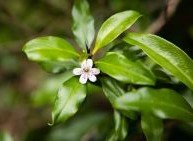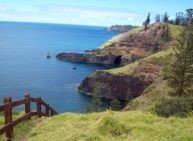Birdwatching
With iconic species like the green parrot and morepork owl, Norfolk Island is home to a fascinating array of birds.
The island’s isolation means that many of these birds aren’t found anywhere else in the world.
The Norfolk Island bird checklist (PDF) is a great way to keep track of what you see during your visit.
Please do not feed any birds on Norfolk Island. Wild birds find their own natural foods like insects and plants, and other foods can make them sick.
Seabirds
Norfolk Island is a seabirds’ paradise, boasting access to the abundant ocean and safe nesting sites high in Norfolk Island Pines or tucked away on steep cliffs.
Wedge-tailed shearwater
Watch the ocean at sunset and you might see these birds floating on the water in large rafts before coming ashore just after nightfall.
Known to the locals as ‘ghost birds’, you can hear their moaning calls echoing across the island at night.
Shearwaters cover vast distances during their annual migration, travelling as far as 300 km a day on their way to Norfolk to breed.
Masked booby
These large, distinctive seabirds have a white body, black tail and a small black mask around their big yellow beak.
Phillip Island, Nepean Island and the Norfolk islets are the main breeding areas for masked boobies, and you can often observe them in their nests between August and February. See if you can spot a chick, which are nearly as big as their parents!
Red-tailed tropicbird
Visiting Norfolk between October and May, these snowy coloured seabirds have rose feathers on the breast and black borders on their wings.
Red-tailed tropicbirds use their bright scarlet tail quills to perform elaborate courtship rituals that may include hovering in a vertical position or flying backwards.
Sooty tern
These birds have a grey back and white underside. You might see them returning to breed in large noisy flocks of several thousand birds.
The local name for the sooty tern is the whale bird, as they arrive back on Norfolk Island during the spring whale migration.
Black noddy
Also known as white-capped noddies, these birds are easily recognised by their black-brown feathers and distinctive white head patch.
During summer, large numbers of black noddies congregate in tall trees on the island. They are known locally as ‘titeracks’ after the sound the adult bird makes.
Forest birds
Norfolk Island National Park’s subtropical rainforest is home to many species of birds that originally came from Australia, New Zealand or New Caledonia.
Most are endemic species or subspecies, having adapted to this island environment over many hundreds of years.
Green parrot
The Green Parrot is the symbol of Norfolk Island National Park and a conservation success story. Thanks to an assisted nesting and rodent control program, this iconic bird is recovering from near extinction.
Keep your eyes peeled in the park for this parrot’s bright green feathers, red crown-patch and blue-edged wings. You should also keep an ear out for their characteristic ‘kek-kek-kek’ call.
Norfolk Island morepork owl
This owl was once the rarest bird in the world, with only one female known to exist.
Although the genetically pure Norfolk Island morepork is now gone, a hybrid species of the original Norfolk Island morepork and New Zealand morepork has a growing population.
You can hear their distinctive ‘more-poooork’ call from dusk until midnight, especially on warm moonlit nights and during the summer breeding season.
Sacred kingfisher
With their blue-grey wings, green back and golden breast, these kingfishers can often be seen perching on branches, posts and powerlines. The local name for these charismatic birds is ‘nuffka’, meaning Norfolker.
Nesting from September to December, they build burrows by flying full speed into the ground to loosen dirt before finishing the job with their claws and beak.
Norfolk robin
The male Norfolk robin has a spectacular red breast, a black back and a white head-patch. The female is brown with a dull orange chest.
Pairs lay two to four eggs in a small nest made from plants and spider webs, camouflaging the exterior with lichens and moss.
This bird was previously thought to be a population of the Australian scarlet robin and then the widespread Pacific robin. However, a 2015 genetic study showed that it is actually a distinct species whose closest relative is the red-capped robin from Australia.
Silvereye
These small birds have the same white eye-ring as other white-eyes (or ‘Grinnells’, as they are often called on Norfolk). However, they can be distinguished from the rest of the genus by their smaller bill and grey back.
Silvereyes have adapted to life on the island both in the forest and around humans. You can find them all year round wherever fruit is available.
Introduced birds
Introduced birds are species that have been brought to Norfolk Island by humans.
Some introduced birds have become major pests and compete with native species for habitat, food and nest sites.
Feral chicken
Widespread on the island, this domestic escapee causes serious disruption to the natural regeneration of native plant species and threatens some of Norfolk Island’s endangered snails.
Feral chickens come in a range of colours including black, white, red-brown, speckled and a mantled metallic-green.
Crimson rosella
Introduced in the early 1800s as a cage bird, this showy parrot is now prolific on the island. It is mostly red with a blue face-patch, tail and wing margins.
Crimson rosellas compete directly with endangered green parrots for nest sites, territory and food.
European blackbird
The male blackbird is usually all black with an orange or yellow beak. Young birds have a brown coloured beak. The female is a plain brown colour with a yellowish beak.
Blackbirds can often be seen feeding on fruits in the treetops or hopping along the ground in search of insects and worms.
Common starling
These glossy birds form large flocks in open pastures and also occur in smaller groups in forested and residential areas.
To distinguish starlings from blackbirds, look at the way they move across the ground – starlings always run, while blackbirds always hop.
Feral pigeon
Pigeons are thought to have arrived on Norfolk in 1790 with the wreckage of the Sirius. They are now common all over the main island.
Their colour varies from pale grey with a metallic green sheen through to dark greyish-black with minimal patterning.
Sign up for Norfolk News
Sign up for our monthly newsletter to receive updates about Norfolk Island National Park.






